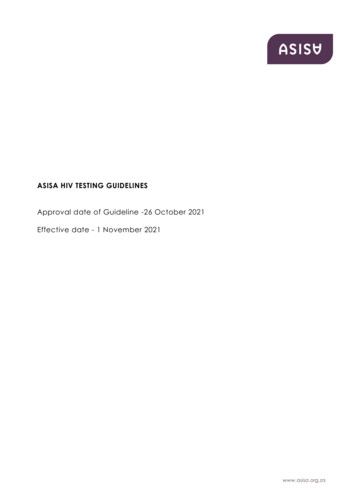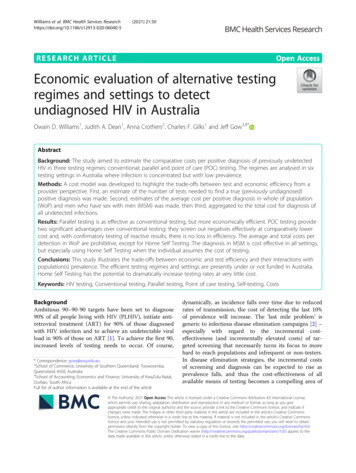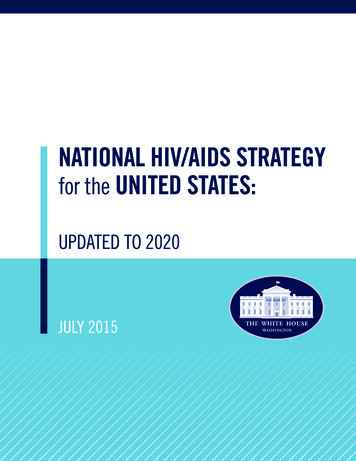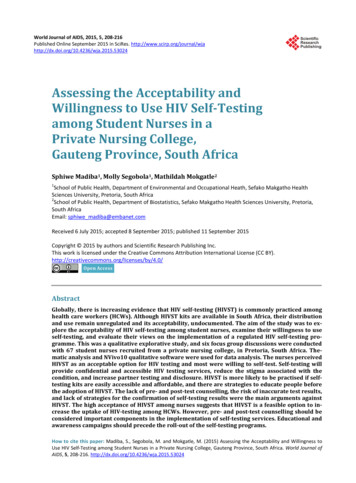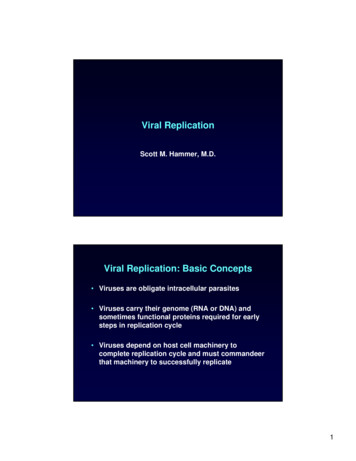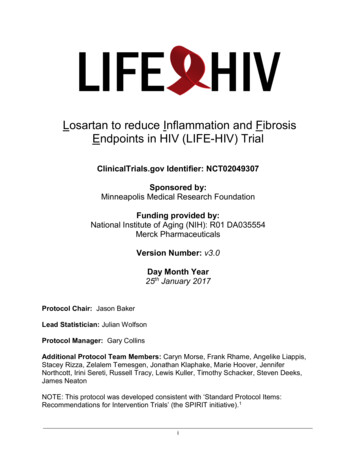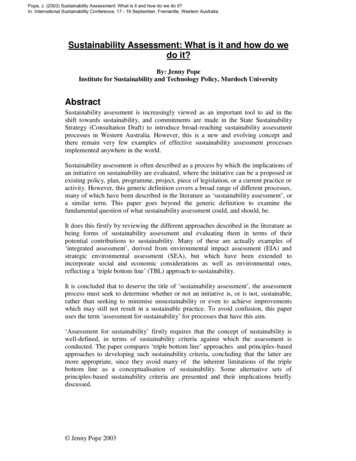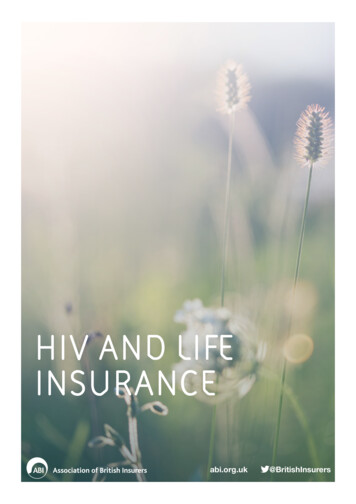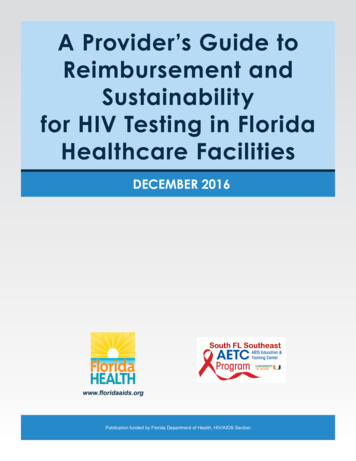
Transcription
A Provider’s Guide toReimbursement andSustainabilityfor HIV Testing in FloridaHealthcare FacilitiesDECEMBER 2016www.floridaaids.orgPublication funded by Florida Department of Health, HIV/AIDS Section
HIV Testing RecommendationsThe Revised Recommendations for HIV Testing of Adults, Adolescents, and Pregnant Women in Health Care Settings(MMWR. September 2006;55[RR-14];1-17. (www.cdc.gov/mmwr/preview/mmwrhtml/rr5514a1.htm) encourage humanimmunodeficiency virus (HIV) testing for patients aged 13 to 64 in all healthcare settings as a routine part of medicalcare, after the patient is notified that testing will be performed unless the patient declines (opt-out screening). Persons athigh risk should be screened for HIV at least annually. Effective July 1, 2015 Florida now has opt-out coverage. Thislaw takes Florida a step closer to removing the stigma of HIV by increasing HIV testing and making it a more routine partof care in our state.The change in the law amends 381.004, F. S. removing the requirement for informed consent prior to HIV testing inhealthcare settings. With this change in statute, the client must be notified that they will be tested for HIV, and they havethe right to decline testing (opt-out) and they must inform the provider that they do not want to be tested. Notification of thetest can be oral or in writing. If the client opts-out, that must be noted in the client’s medical record.In non healthcare settings such as community based organizations informed consent is still required, but not necessarilywritten informed consent. The requirement for written, informed consent is actually established in rule (64D-2) and themodel protocol. Statute only requires that “a provider shall obtain the informed consent of the person upon whom thetest is to be performed. Informed consent shall be preceded by an explanation of the right to confidential treatment ofinformation identifying the subject of the test and the results of the test as provided by law.”(http://laws.flrules.org/2015/110)HIV screening is supported by the revised CDC recommendations as a normal part of medical practice, comparable toscreening for other treatable conditions. Screening as a basic health tool is used to identify unrecognized health conditionsso treatment can be offered before symptoms develop and to implement interventions to reduce the likelihood of continuedtransmission of communicable diseases.HIV infection is consistent with all generally accepted criteria that justify screening: (1) HIV infection is a serious healthdisorder that can be diagnosed prior to the development of symptoms; (2) HIV infection can be identified by reliable,inexpensive and noninvasive screening tests; (3) infected patients have years of life to gain if treated early, beforesymptoms develop and; (4) screening costs are reasonable in relation to the anticipated benefits. Among pregnantwomen, screening has proven significantly more effective than risk-based testing for detecting unsuspected maternal HIVinfection and preventing perinatal transmission.The U.S. Preventive Services Task Force (USPSTF) recommends that clinicians screen for HIV infection in adolescentsand adults ages 15 to 65 years. Younger adolescents and older adults who are at increased risk should also bescreened. The USPSTF recommends that clinicians screen all pregnant women for HIV, including those who present inlabor who are untested and whose HIV status is unknown. These are both Grade “A” Recommendations. USPSTFrecommendations available online at f/uspshivi.htm.Under the Affordable Care Act, Medicare, Medicaid and private insurance are either required or incentivized tocover “A” and “B” graded services.Sustaining an HIV Testing Intervention ProgramCoverage of preventive health services, including HIV testing, is required through the Patient Protection andAffordable Care Act (PPACA). Achieving sustainability of an HIV testing intervention may, over time, involveone or more strategies. Recommendations for maintaining sustainability offered in this guide are merelysuggestions that may be utilized when evaluating the objectives and needs of the individual healthcare settingRecommendations Seek reimbursement by billing Medicaid, Medicare, or other third-party payers for HIV/AIDS testing services. Train staff on billing and coding Make adequate time for staff to address billing and coding issues Assess current billing and reimbursement practices, infrastructure for billing and reimbursement, status of healthinformation technologies, and challenges and technical assistance needs. If not already in place, consider using electronic health records (EHR) to maximize health information technologycapacity Monitor rate of reimbursement for each payer Update or implement information technology infrastructure (billing software) Network and share practices with other agenciesSeek technical assistance on third-party billing/reimbursement from other agenciesSubmit grant applications (to purchase kits)Utilize a community-based organization to visit the clinical site to perform HIV testingIdentify a “champion” to provide ongoing support and promotion of HIV testing within the health care facilityHave an electronic clinical reminder that encourages providers to offer HIV testingCoding Guidelines for RoutineHIV Testing in Healthcare SettingsCPT Search.doTest ProductCode86689Antibody; HTLV or HIV antibody; confirmatory test (e.g., Western Blot)86701Antibody; HIV-1; single result86702Antibody; HIV-2; single result86703Antibody; HIV-1 and HIV-2, single assay87534Infectious agent detection by nucleic acid (DNA or RNA); HIV-1, direct probe technique87535Infectious agent detection by nucleic acid (DNA or RNA); HIV-1, amplified probe technique87536Infectious agent detection by nucleic acid (DNA or RNA); HIV-1, quantification87537Infectious agent detection by nucleic acid (DNA or RNA); HIV-2, direct probe87538Infectious agent detection by nucleic acid (DNA or RNA); HIV-2, amplified probe87539Infectious agent detection by nucleic acid (DNA or RNA); HIV-2, quantification87389Infectious agent detection by enzyme immunoassay technique, HIV-1 antibody with HIV-1 and HIV-2antigens; qualitative or semi-quantitative; single step87390Infectious agent antigen detection by enzyme immunoassay technique, qualitative orsemi-quantitative, multiple-step method; HIV-187391Infectious agent antigen detection by enzyme Immunoassay HIV-2; qualitative or semi-qualitative;multi-stepCode36415CodeTest AdministrationDescriptionCollection of venous blood by venipunctureOffice ServiceDescription99385Initial comprehensive preventive medicine service evaluation and management18-39 years of age (new patient)99386Initial comprehensive preventive medicine service evaluation and management40-64 years of age (new patient)99395Periodic comprehensive preventive medicine reevaluation and management18-39 years of age (established patient)99396Periodic comprehensive preventive medicine reevaluation and management40-64 years of age (established patient)99211 - 99215Code99401 - 994041DescriptionOffice or other outpatient visit for the evaluation and management of an established patient that maynot require the presence of a physician (code based on time spent, 5 minutes - 40 minutes)Pre- and Post-HIV Test CounselingDescriptionPreventive medicine counseling or risk factor reduction intervention(s) provided to an individual;(code based on time spent, 15 minutes - 60 minutes)2
Coding Guidelines for RoutineHIV Testing in Healthcare SettingsCoding Modifiers for HIV Testing in Healthcare SettingsCoding ModifierSpecial Coding Instructions33Use to indicate a preventive service for which a patient’s co-pay, deductible or co-insuranceis waived; need not use if service is inherently preventive; when billing an E/M service withpreventive services for same visit, when the main reason for the visit is for preventive services, copays, coinsurance, or deductibles will not apply.92QWFor use when laboratory testing is being performed using a kit or transportable instrument thatwholly or in part consists of a single use, disposable analytical chamber; use with CPT coderange 86701-86703, G0435 only.Clinical Laboratory Improvement Amendments (CLIA) waived test. Waived tests include test systemscleared by the Food and Drug Administration (FDA) designated as simple, have a low risk for errorand approved for waiver under the CLIA criteria. Use with test codes 86701-86703, G0433-G0435.Do NOT report on any other code type. If a combination of waived and un-waived tests areperformed, do not use modifier QW.* Check with your local Medicaid provider for the appropriate modifier.Note: Correct order – and linking—of diagnosis codes is key for reimbursement purposes.ICD-9-CM and ICD-10-CM Diagnosis Codes Comparison ately to: Z00.00 - Encounter for general adult medical examination without abnormal findingsApproximately to: Z11.59 - Encounter for screening for other viral diseasesApproximately to: Z72.89 - Other problems related to lifestyleDirectly to:Z71.7 - Human immunodeficiency virus [HIV] counselingDirectly to:Z21 - Asymptomatic human immunodeficiency virus [HIV] infection statusApproximately to: R75 - Inconclusive laboratory evidence of human immunodeficiency virus [HIV]Directly to:B20 - Human immunodeficiency virus [HIV] diseaseApproximately to: Z34.00 - Encounter for supervision of normal first pregnancy, unspecified trimesterV22.1Z34.80 - Encounter for supervision of other normal pregnancy, unspecified trimester, or:Approximately to: Z34.90 - Encounter for supervision of normal pregnancy, unspecified, unspecifiedtrimesterV23.9O09.90 - Supervision of high risk pregnancy, unspecified, unspecified trimester or:O09.91 - Supervision of high risk pregnancy, unspecified, first trimester or:Approximately to:O09.92 - Supervision of high risk pregnancy, unspecified, second trimester or:O09.93 - Supervision of high risk pregnancy, unspecified, third trimester079.53Directly to:B97.35 - Human immunodeficiency virus, type 2 [HIV 2] as the cause of diseasesclassified elsewhereV67.9Approximately to:Z09 - Encounter for follow-up examination after completed treatment for conditionsother than malignant neoplasmV69.2Approximately to: Z72.51 - High risk heterosexual behaviorMedicareChanges in Medicare Testing GuidelinesIn April 2015, Medicare issued a national coverage determination based on the USPSTF’s 2013 recommendations.Medicare now covers once-annual HIV screening for all beneficiaries age 15-65, without co-payment, regardless of risk.Pregnant women are covered for three tests, and those under age 15 and older than 65 who are “at increased risk” arecovered for one test ermining the Appropriate Primary ICD-10-CM Diagnosis Code for DiagnosticTests Ordered Due to Signs and/or SymptomsIf the provider has confirmed a diagnosis based on the results of the diagnostic test, the physician interpreting the testshould code that diagnosis. The signs and/or symptoms that prompted ordering the test may be reported as additionaldiagnoses if they are not fully explained or related to the confirmed diagnosis.Incidental FindingsIncidental findings should never be listed as primary diagnoses. If reported, incidental findings may be reported assecondary diagnoses by the physician interpreting the diagnostic test.Diagnostic Tests Ordered in the Absence of Signs and/or SymptomsWhen a diagnostic test is ordered in the absence of signs/symptoms (e.g., screening tests) or other evidence of illness orinjury, the physician interpreting the diagnostic test should report the reason for the test (e.g., screening) as the primaryICD-10-CM diagnosis code. The results of the test, if reported, may be recorded as additional diagnoses.Healthcare Common Procedure Coding System (HCPCS) Codes for Billing MedicareCodeDescriptionG0432Infectious agent antibody detection by enzyme immunoassay (EIA) technique, HIV-1 and/orHIV-2, screeningG0433Infectious agent antibody detection by enzyme-linked immunosorbent assay (ELISA)technique, HIV-1 and/or HIV-2, screeningG0435Infectious agent antibody detection by rapid antibody test, HIV-1 and/or HIV-2, screeningNote: These codes can only be claimed with use of the corresponding ICD-10-CM diagnosis codes.Accompanying Diagnosis Codes1. For beneficiaries reporting increased risk factors, use HCPCS code G0432, G0433, or G0435 with diagnosis codeZ11.59 (“Encounter for screening for other viral diseases”) as primary; with diagnosis code Z72.89 (“Otherproblems related to lifestyle”) as secondary.or2. For beneficiaries not reporting increased risk factors, claims shall contain HCPCS code G0432, G0433 or G0435 withdiagnosis code Z11.59 only.3. For pregnant women, use diagnosis code Z34.00, Z34.80 or Z34.90NOTE: Medicare pays for voluntary HIV screening a maximum of once annually for beneficiaries at increased risk for HIVinfection.NOTE: Medicare pays for voluntary HIV screening of pregnant Medicare beneficiaries a maximum of three times per termof pregnancy beginning with the date of the first test when ordered by the woman’s clinician: (1) when the diagnosis ofpregnancy is known, (2) during the third trimester, and (3) at labor, if ordered by the woman’s physician.DISCLAIMER: This guide was prepared as a resource for healthcare professionals and is onlyintended to be a general summary. It is not intended to take the place of written law, regulationsor professional judgment. We encourage readers to review the specific statutes, regulations andother materials for a full and accurate statement of their contents.34
Coding Scenarios for Routine and Rapid HIV Testing in Healthcare Facilities(See descriptive ICD-10-CM and CPT Codes to identify the set of codes that best reflect the status of he patient being tested)Example 1: Non-established Patient VisitA private practice physician sees a 25-year-old male for his annual wellness exam. The patient, who is not anestablished patient, states that he has had multiple sexual partners, both male and female. The physician shouldperform a rapid HIV test.To bill use:ICD-10-CM Diagnosis Codes: Z00.00; Z11.59 or Z72.89; Z71.7; Z21; B20CPT CODESTest Product: 86701 with modifier 92 or QW, or 86703 with modifier 92 or QW, or 87390 with modifier 92Office Service: 99385Example 2: Established Patient VisitA 35-year-old married female with allergy complaints visits her primary care physician. She is an established patient;therefore, the physician can perform either the conventional or a rapid HIV test.To bill use:ICD-10-CM Diagnosis Codes: Z11.59; Z21 or B20; Z71.7NOTE: These codes should be reported in addition to those codes appropriate to allergy complaints reported by thepatient (either a confirmed diagnosis of allergy, or the specific signs or symptoms).CPT CODESTest Product: 86701 with modifier 92 or QW; Office Service: 99211- 99215Example 3: Emergency Department VisitA 38-year-old male visits the Emergency Department with a prolonged cough and pain in the chest, and indicatessexual risk behavior. The attending physician can either perform a conventional HIV test or a rapid HIV test.To bill use:ICD-10-CM Diagnosis Codes: Z11.59 or Z72.89; Z71.7; Z21; B20;CPT CODESTest Product: 86701 with modifier 92, or 86703 with modifier 92, or 87390 with modifier 92Office Service: 99281-99288NOTE: Physician billing for emergency department services provided to patient by both the patient’s personal physicianand/or ED physician.Example 4: Established Patient--Coding Modifier 33An 18-year-old female visits her physician’s office for a routine general medical examination. She requests an HIVtest because she is in a sexual relationship and she has read a poster at her school that the CDC’s recommendationsencourage HIV testing in individuals ages 13 to 64 in all healthcare settings. The physician can either perform aconventional HIV test or a rapid HIV test.To bill use:ICD-10-CM Diagnosis Codes: Z11.59; Z21 or B20; Z71.7CPT CODESTest Product: 86701 with modifier 92 or QW; Test Administration: 36415; Office Service: 99211- 99215Example 4: Medicare Patient visit (Health Care Common Procedure Coding System)A 66-year-old gay male visits his physician’s office for his annual checkup, and indicates sexual risk behavior. Thepatient is covered by Medicare; therefore, the physician can either order a conventional HIV test or a rapid HIV test.ICD-10-CM Diagnosis Codes: Z11.59 with Z72.89; Z71.7HCPCS: G0432, or G0433 or G0435Florida Individual Health Insurance Plans Preventive Services Coverage for HIV TestingHealth PlanReimbursementAetnaHIV screening is covered according to available screening 0 599/0542.htmlAvMedFor plans beginning on or after September 23, 2013, HIV screening is covered for all adults at"higher risk," per USPTF guidelines including high community prevalence: g HIV test covered with primary associated ICD-10-CM for prevention services (NOT fortreatment of illness or injury). For additional info visit: entive-care-fact-sheetHealth FirstHealth PlansInc.,MagellanScreening HIV test covered with primary associated ICD-10-CM for prevention services (NOT fortreatment of illness or injury).For additional info visit: reventive coverage.pdfHumanaMedicaidHIV screening is covered for all adults at "higher risk," per USPTF guidelines including highcommunity prevalence when ordered through an in-network PCP. For additional info visit: idelinesMust cover medically necessary HIV testing. http://www.aahivm.org/flexpansionNOTE: We are unable to provide a list of private health insurance plans as new plans and changes in plans are difficult to keep updated. Please refer toeach individual health plan to verify reimbursement coverage for HIV TestingFor a complete list of health plans offered in Florida, ompare.aspx.References1. American Medical Association, American Academy of HIV Medicine. CPT – Current Procedural Terminology. insurance/cpt.page.Accessed December 1, 2016.2. Centers for Disease Control and Prevention. Revised recommendations for HIV testing of adults, adolescents, andpregnant women in health-care settings. MMWR. September 2006;55(RR-14);1-17. htm. Accessed December 1, 2016.3. Centers for Medicare and Medicaid Services (CMS). CMS.gov. http://www.cms.gov/Medicare/Medicare.html.Accessed December 1, 2016.4. Florida Health Finder. Health Plan Information. ault.aspx.Accessed December 1, 2016.5. Health First Health Plans, Inc. http://www.health-first.org/health plans/. Accessed Dcember 1, 2016.6. National Alliance of State & Territorial AIDS Directors. Issue Brief: Billing and Reimbursement. Health Departmentsand Capacity for Third-Party Billing and Reimbursement: A Status Report and Resources for Capacity -Billing-April-2013.pdf. Accessed December 1, 2016.7. National Alliance of State &Territorial AIDS Directors. Sample Local Survey on Third-Party Billing and Reimbursementfor HIV/AIDS and Viral Hepatitis Services. ursement-Survey.pdf. Accessed September 13, 2015.8. American Medical Association "Coding and Billing: CPT Codes". Available at https://www.ama-assn.org/practicemanagement/cpt. Accessed December 10, 2016.9. “Aetna Policy 0542: HIV Testing." http://www.aetna.com/cpb/medical/data/500 599/0542.html. Updated September 1,2016; Accessed December 1, 2016.10. Screening for HIV. Current Recommendations. U.S. Preventive Services Task Force. f/uspshivi.htm. Accessed December 1, 2016.56
RESOURCESAmerican Medical Associationwww.ama-assn.orgAmerican Academy of HIV Medicinewww.aahivm.orgCenters for Disease Control and Preventionwww.cdc.govCenters for Medicare and Medicaid Serviceswww.cms.gov/center/coverage.aspHIV Medicine Associationwww.hivma.orgNational Alliance of State and Territorial AIDS Directorswww.nastad.orgThe Professional Association of Healthcare Coding Specialistswww.pahcs.orgFlorida Department of Healthwww.preventhivflorida.comREVISED DECEMBER 2016
Periodic comprehensive preventive medicine reevaluation and management 18-39 years of age (established patient) 99396 Periodic comprehensive preventive medicine reevaluation and management 40-64 years of age (established patient) 99211 - 99215 Office or other outpatient visit for the evaluation and management of an established patient that may

